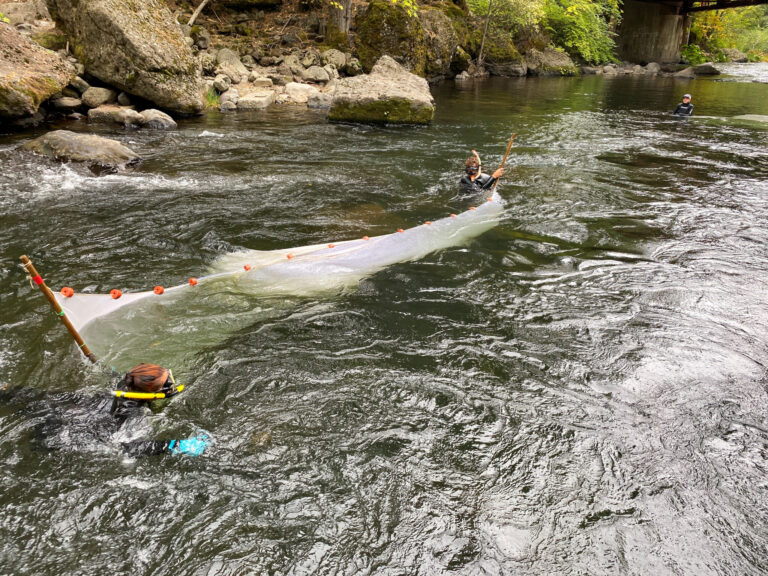California Water Policies Decimate Threatened Central Valley Spring-Run Chinook Salmon California Department of Fish and Wildlife environmental scientists herd yearling spring-run Chinook salmon into a waiting net. Deer Creek, Tehama County, Oct. 10, 2023. (CDFW Photo/Peter Tira)
California Water Policies Decimate Threatened Central Valley Spring-Run Chinook Salmon
Today, the California Department of Fish and Wildlife and the National Oceanic and Atmospheric Administration (NOAA) Fisheries announced an emergency action plan to capture Central Valley spring-run Chinook salmon juveniles in a move to prevent extinction of the threatened species. The captured juvenile spring-run will be raised to adulthood at UC Davis, in an effort to save this run’s unique genetic heritage.
Spring-run salmon were declared threatened in 1999 under the Endangered Species Act and experienced catastrophically low survival in 2021. This news is another blow to California’s salmon stocks and a beleaguered fishing industry impacted by the complete closure of the 2023 commercial fall-run Chinook salmon season. The closure has resulted in the loss of tens of thousands of jobs in California and Oregon, erased incomes for thousands of families, and threatens the survival of coastal communities.
“We applaud and support the California Department of Fish and Wildlife and the National Oceanic and Atmospheric Administration Fisheries for implementing this critical action to save wild salmon,” said Scott Artis, executive director of Golden State Salmon Association. “But this current situation could have been avoided if Governor Newsom, state agencies and the Bureau of Reclamation had focused on the biological needs of salmon as much as they cater to industrial agriculture’s thirst for water to grow almonds and other nut crops for export.”
Rejecting calls from Golden State Salmon Association, environmental organizations, environmental justice groups and tribes over the last decade to restore the health of California’s rivers, the Bureau of Reclamation (BOR), even during drought, has continued to divert the water salmon need to survive from the Sacramento River. The BOR has the authority to reduce these diversions and provide life-saving cold water for salmon. Unfortunately, it has failed to do so even as the warning signs of devasting losses and low salmon returns continue to pile up.
During the last few years, spring-run Chinook have continued to be exposed to harmful water temperatures and dangerously low water flows in our rivers, including the Sacramento. In Butte Creek, the Central Valley’s spring-run Chinook salmon stronghold, high river temperatures in the summer of 2021 forced salmon into limited river habitat, which resulted in outbreaks of disease that killed nearly all adult spring-run fish prior to spawning. The following year, only 5,132 wild spring-run salmon returned to spawn. In August 2023, a breach on PG&E’s Butte Canal, which carries water to their De Sabla Powerhouse, caused rust colored sediment to spill into and thoroughly pollute Butte Creek. The pollution event resulted in the destruction of salmon habitat and killed threatened spring-run fish.
The State Water Board continues to fail to […]
Full article: goldenstatesalmon.org

